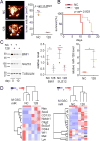MicroRNA-Mediated Dynamic Bidirectional Shift between the Subclasses of Glioblastoma Stem-like Cells
- PMID: 28591575
- PMCID: PMC5514838
- DOI: 10.1016/j.celrep.2017.05.040
MicroRNA-Mediated Dynamic Bidirectional Shift between the Subclasses of Glioblastoma Stem-like Cells
Abstract
Large-scale transcriptomic profiling of glioblastoma (GBM) into subtypes has provided remarkable insight into the pathobiology and heterogeneous nature of this disease. The mechanisms of speciation and inter-subtype transitions of these molecular subtypes require better characterization to facilitate the development of subtype-specific targeting strategies. The deregulation of microRNA expression among GBM subtypes and their subtype-specific targeting mechanisms are poorly understood. To reveal the underlying basis of microRNA-driven complex subpopulation dynamics within the heterogeneous intra-tumoral ecosystem, we characterized the expression of the subtype-enriched microRNA-128 (miR-128) in transcriptionally and phenotypically diverse subpopulations of patient-derived glioblastoma stem-like cells. Because microRNAs are capable of re-arranging the molecular landscape in a cell-type-specific manner, we argue that alterations in miR-128 levels are a potent mechanism of bidirectional transitions between GBM subpopulations, resulting in intermediate hybrid stages and emphasizing highly intricate intra-tumoral networking.
Keywords: Polycomb repressive complex; chromatin; exosomes; glioblastoma; heterogeneity; microRNA; non-coding RNA; stem cells; subtype transition.
Copyright © 2017 The Author(s). Published by Elsevier Inc. All rights reserved.
Conflict of interest statement
The authors have declared no conflict of interest.
Figures




References
-
- Bian EB, Li J, He XJ, Zong G, Jiang T, Li J, Zhao B. Epigenetic modification in gliomas: role of the histone methyltransferase EZH2. Expert opinion on therapeutic targets. 2014;18:1197–1206. - PubMed
-
- Bracken AP, Helin K. Polycomb group proteins: navigators of lineage pathways led astray in cancer. Nature reviews Cancer. 2009;9:773–784. - PubMed
Publication types
MeSH terms
Substances
Grants and funding
LinkOut - more resources
Full Text Sources
Other Literature Sources
Molecular Biology Databases

